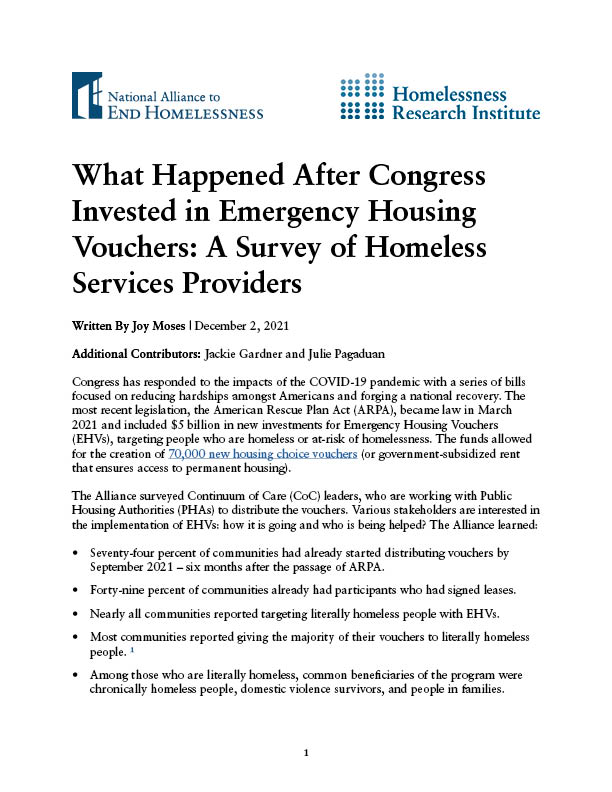Table of Contents
Congress has responded to the impacts of the COVID-19 pandemic with a series of bills focused on reducing hardships amongst Americans and forging a national recovery.
The most recent legislation, the American Rescue Plan Act (ARPA), became law in March 2021 and included $5 billion in new investments for Emergency Housing Vouchers (EHVs), targeting people who are homeless or at-risk of homelessness. The funds allowed for the creation of 70,000 new housing choice vouchers (or government-subsidized rent that ensures access to permanent housing).
What Happened After Congress Invested in Emergency Housing Vouchers: A Survey of Homeless Services Providers
The Alliance surveyed Continuum of Care (CoC) leaders, who are working with Public Housing Authorities (PHAs) to distribute the vouchers. Various stakeholders are interested in the implementation of EHVs: how it is going and who is being helped? The Alliance learned:
- Seventy-four percent of communities had already started distributing vouchers by September 2021 – six months after the passage of ARPA.
- Forty-nine percent of communities already had participants who had signed leases.
- Nearly all communities reported targeting literally homeless people with EHVs.
- Most communities reported giving the majority of their vouchers to literally homeless people. 1
- Among those who are literally homeless, common beneficiaries of the program were chronically homeless people, domestic violence survivors, and people in families.
This survey dug into the basics of EHV implementation. Further research is necessary to understand the more layered aspects of current efforts, such as how many groups were prioritized, the dynamics of agency partnerships, and any barriers tenants may be facing obtaining and maintaining housing.
Methodology
The Alliance surveyed senior-level Continuum of Care (CoC) staffers from across the country via Survey Monkey. An email list was obtained from the U.S. Department of Housing and Urban Development (HUD)’s Grantee Contact Page on September 9, 2021. Each CoC had multiple contacts. There are 392 CoCs, and the survey went out to 750 unique email addresses. Six emails (0.8 percent) bounced back as undeliverable.
The initial request had a deadline of September 30, 2021. A reminder email was sent to non-responders on September 20, 2021. Between October 4 and 12, 2021, Alliance staff called 56 randomly selected CoCs that had not completed the survey. This yielded responses from 7 additional communities.
There was a total of 172 responses. After de-duplication, 152 unique CoCs were represented (39 percent of all CoCs in the country). Most participants answered all the survey questions.
Progress with Implementation
Once ARPA became law, multiple steps would have to occur before individuals and families could actually move into housing. For instance, 1) HUD would have to determine how many vouchers would be allocated to each jurisdiction, 2) CoCs and PHAs would have to develop Memorandums of Understanding documenting how they would work with one another, 3) communities would have to decide who of the eligible populations should get the vouchers, and 4) participants would have to find landlords willing to rent to them.
The Alliance’s survey sought a general understanding of how quickly government agencies, CoCs and participants were moving through these processes.
Six months after the passage of ARPA, an overwhelming majority of CoCs (74 percent) reported that their communities had already started distributing EHVs to individuals and families. Only 2 percent of communities were still in the planning phase.

Nearly half (49 percent) of locations already had households that had signed leases. However, a sizable proportion (42 percent) were still working towards that goal.
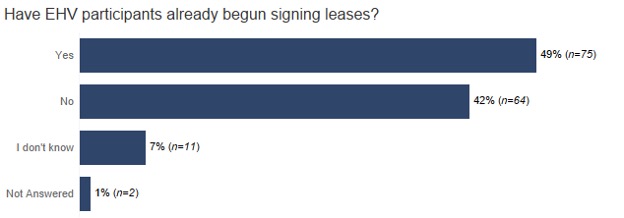
In pursuing the goal of keeping the survey simple, the Alliance did not ask participants to quantify their progress—i.e., to share the total number of vouchers distributed and total households that had signed leases. Thus, for any one community responding to the survey, those numbers could have ranged from 1 to many.
Importantly, as the Alliance research team was working on this report, HUD published a dashboard containing community-specific data that answers these questions. It will be periodically updated.
Reaching People Who Are Literally Homeless
Congress authorized the distribution of Emergency Housing Vouchers to “literally homeless” people, meaning those who are unsheltered or living in temporary housing (such as congregate shelters or motel/hotel programs). However, other groups are also eligible for EHVs, including domestic violence survivors, people who are currently housed in permanent supportive housing (PSH) and rapid re-housing (RRH), and people at risk of becoming homeless.
A primary aim of the survey was to understand the degree to which the vouchers are reducing literal homelessness. Almost all CoCs (95 percent) indicated that their communities were targeting people experiencing literal homelessness for receipt of EHVs.
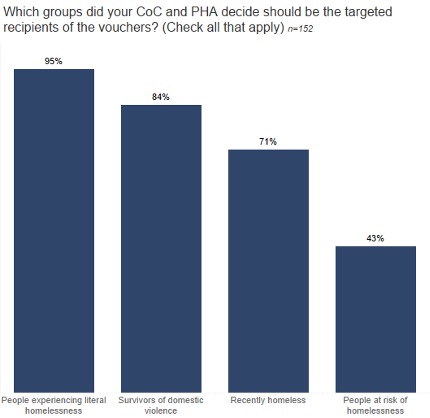
And most communities (57 percent) reported that most of their vouchers are going to this group.
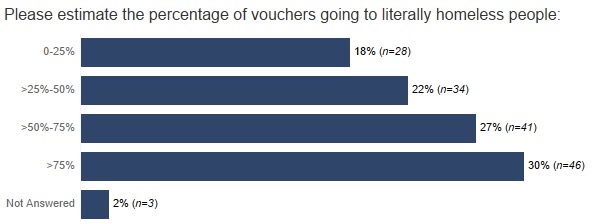
Definition Confusion and Two Ways to Reduce Literal Homelessness
This survey utilized the structures and definitions outlined by Congress and the U.S. Department of Housing and Urban Development. Some elements are not intuitive.
One term of note is “literal homelessness”. Many people in the homeless services field are familiar with the definition of the term, since it is included in the Hearth Act of 2009 (legislation that plays a central role in the work of CoCs) and acts to limit who can and who cannot receive some of the services they deliver. However, in reviewing some of the survey responses, it became apparent that a subset of participants may have misclassified people in permanent housing that is a part of a homeless services system (i.e., PSH and RRH). Precisely, they may have thought of people in PSH and RRH as being “literally homeless” when these households do not actually fit within that definition, and are considered housed.
The Alliance is unable to determine how many respondents misinterpreted this term.
This issue raised an important question about the above section: Was the Alliance’s survey overstating 1) the number of communities using their vouchers to reduce literal homelessness and 2) the share of vouchers benefitting this group?
It became clear that even if some respondents counted housed PSH and RRH participants among the “literally homeless” households that received vouchers, at least some literally homeless households might still be impacted by the EHVs.
The reason is that there is more than one way to impact literal homelessness. Extending an EHV to a literally homeless household would obviously end homelessness for one household. However, if an EHV were given to a household currently residing in PSH, that PSH unit would be free up for a literally homeless household to move in, with a net result of ending homelessness for one household. 2
The exact size is heavily dependent upon 1) the number EHV recipients who wouldn’t have otherwise moved on from PSH and RRH and 2) the number of successful entries of literally homeless people into PSH and RRH as a result. Further work is needed to determine this information.
Subgroups Prioritized within Literal Homelessness
Some communities are prioritizing specific subpopulations within literal homelessness for the program. These decisions are rooted in a multitude of community factors and the discretion of community leaders.
The most popular targets for EHVs as outlined in the survey were homeless people who were: 1) chronically homeless people, 2) domestic violence survivors, and 3) people in families.
Although most locations favored these groups, nearly half (47 percent) prioritized unsheltered people for EHVs. The group is underserved, and they tend to have far greater health-related challenges than their sheltered counterparts. Unfortunately, these barriers can be an incentive to leave this group behind and instead focus on people who are easier to serve. Thus, for stakeholders invested in reaching deeply vulnerable people experiencing homelessness, it is a hopeful sign that so many communities have created some sort of priority for the unsheltered. 3

A minority of communities is also prioritizing older adults, individual adults, and youth. Survey participants wrote in additional categories targeted for the receipt of vouchers, including:
- historically marginalized and underserved racial/ethnic groups;
- individuals exiting prisons and jails;
- people with disabilities;
- people particularly vulnerable to COVID-19 or who have COVID-19;
- people placed in non-congregate shelters (typically hotels or motels) due to the pandemic;
- people who have been homeless for long periods of time, but do not qualify as “chronic” because they aren’t disabled;
- long-term shelter stayers;
- people ineligible for PSH, HUD-VASH (VA Supportive Housing), or the mainstream housing choice voucher program (including those in rural areas not normally reached by the program);
- individuals/families with fixed incomes (e.g., social security or disability insurance) that make it difficult for them to move on from RRH; and
- families involved in the child welfare system
The Alliance’s simplified survey did not request detailed information about the structure of prioritization systems or about the number of vouchers designated or distributed to each group.
Reaching Others Targeted by EHVs
Many communities are targeting Congressionally-approved groups that are not literally homeless, including:
- Domestic Violence Survivors (Targeted by 84 percent of communities): These individuals and families are fleeing domestic violence, sexual assault, stalking, or human trafficking. Some are unsheltered or in temporary shelters, but ARPA does not require EHV participants to be in those situations.
- Recently Homeless (Targeted by 71 percent of communities): Despite the label, this group is not literally homeless. According to Congress, they are people “for whom providing rental assistance will prevent the family’s homelessness or having high risk of housing instability.” HUD has specified that residents moving on from PSH and RRH can be included in the “recently homeless” category.
- People At-Risk of Homelessness (Targeted by 43 percent of communities): People fall into this category for reasons that include meager incomes, frequent moves due to economic reasons, doubling up, or being in severely overcrowded housing.
Everyone is deserving of housing and individuals falling into the above categories can be particularly vulnerable. However, reaching these groups will not necessarily reduce literal homelessness. Some domestic violence survivors receiving EHVs may not be homeless and may have never experienced homelessness (even without a voucher). Some “recently homeless” people in PSH or RRH may have been able to move on without a voucher. And many people who are at risk of homelessness never become homeless.
Tracking and Future Reporting
An overwhelming majority of CoCs (89 percent) indicate that their communities are tracking the number of literally homeless people who are awarded EHVs in the Homeless Management Information System (HMIS) or another database.
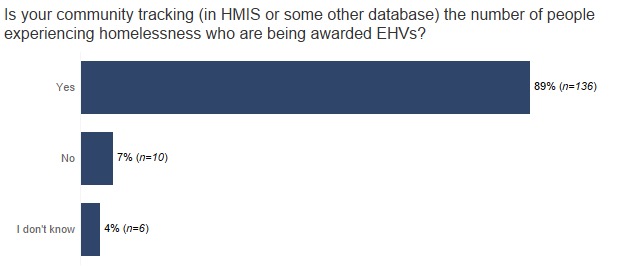
Importantly, the existence of this data will allow for future research on program participation and the successes and failures of EHVs. Such analysis should inform future policy decisions.
Future Research
The current survey represents an early attempt to understand factors tied to utilizing ARPA’s Emergency Housing Vouchers. In the months and perhaps years to come, various research teams will likely study aspects of this critical program, which is providing aid to Americans amid a pandemic and a protracted affordable housing crisis.
At a minimum, this survey suggests the following are worthy of future research and exploration:
- Take-Up Refusals. Some of the CoCs the Alliance contacted had Public Housing Authorities that declined to participate in the EHV program. Why? Do identified barriers affect the delivery of services in other areas? How can existing barriers best be addressed? How did non-participation impact communities?
- Detailed Process Information. More data on the timing of distribution would be useful. For example, how long did it take for communities to give out 50 percent or 100 percent of EHVs? Similarly, what are the average elapsed times between voucher receipt and a lease signing? Further, what barriers were encountered on the roads to voucher distributions and lease signings? What best practices were developed in response?
- Move On Participants. What percentage of vouchers are going to people moving on from PSH and RRH? What characteristics were shared by these participants? Is it possible to determine what and how many participants would have been able to move on without EHVs?
- Replacement PSH and RRH Participants. Some EHVS are being used to help PSH and RRH participants move on from those programs. When these individuals/families vacate their housing, resources are freed up. To what extent is PSH and RRH made available to new participants? What characteristics are shared by the new participants? To what extent are there barriers to their participation in PSH and RRH (e.g., a lack of needed supportive services)? How are communities overcoming those barriers and how long does it take them to do so?
- Subgroup Targeting. Many communities indicate that they are in some way tracking who is receiving vouchers. Where possible, it would be informative to know what percentage of vouchers are going to targeted subgroups. What best practices are being developed for reaching and serving each group? How are EHVs impacting subgroup members?
Conclusion
Homelessness has been on the rise since 2017. A global pandemic has slammed down on national and local economies, disabling some industries and reshaping the job market. Congress has responded with legislation that included $5 billion in new investments for Emergency Housing Vouchers aimed at keeping homeless counts as low as possible. Given the context, communities across the country must effectively seize the opportunity to alleviate existing challenges.
Within six months, most communities had started issuing vouchers, and nearly half had started seeing participants sign leases. Most of the survey respondents reported that most of their resources are being aimed at reducing literal homelessness. 4 Although it is possible that some may have misunderstood the phrase “literal homelessness” to include people in PSH and RRH, move on efforts from these programs (depending on how they are structured) may still be contributing to reductions in literal homelessness.
EHVs are reaching vulnerable populations, especially those who are chronically homeless, domestic violence survivors, and people in families. And some communities are using EHVs to address long-existing racial inequities and reach subgroups that too often fall between the cracks (such as formerly incarcerated individuals and non-disabled people experiencing long-term homelessness).
All of the above point to potentially positive impacts of EHVs on homelessness. However, this survey covers the very basics of implementation. In the months and years to come, researchers will have to dig deeper into 1) the challenges that inevitably arise in such large-scale efforts, and 2) best practices being developed by innovators in the field.
Limitations
There are some notable limitations to the analysis and generalizability of this survey. Thirty-nine percent of all CoCs responded to the survey. Thus, the potentially unique responses of the remaining CoCs are not accounted for in our findings. Survey and item nonresponse are unlikely to be random, with factors such as staff time, ability to gather requested data items, and political considerations likely influencing completion rates. Therefore, the Alliance cannot generalize findings from this survey to other communities. In addition, all data are self-reported. Beyond removing obvious data entry errors, the Alliance was unable to validate the responses.
Despite these limitations, the findings offer a unique view of the early stages of EHV implementation, providing a glimpse into the implementation process and the groups and subgroups benefiting from the program.
Citations
- This does not necessarily mean that the majority of vouchers are going to literally homeless households. Many communities did not respond to the survey—this sample may not have been representative of all communities. And there is always a possibility that some respondents misreported some information.
- It is possible that giving a household in Rapid Re-Housing a voucher might also free up the RRH subsidy for another household. However, RRH is a short term subsidy program – not a unit or a permanent voucher. A voucher given to a RRH household is much less likely to free up a fully funded RRH subsidy for a homeless household, and thus less likely to reduce homelessness by one household.
- It should be noted that any number of subpopulations can be prioritized, therefore this does not necessarily mean these subpopulations will receive the most vouchers in a given community.
- It should be noted that although the majority of responding CoCs surveyed reported that they are targeting most of their resources to literally homeless households, this does not necessarily mean that the majority of the vouchers are going to literally homeless households. This is because many communities didn’t answer the survey (respondents’ answers may not be representative of the whole) and some respondents may have reported inaccurate information.
Appendix
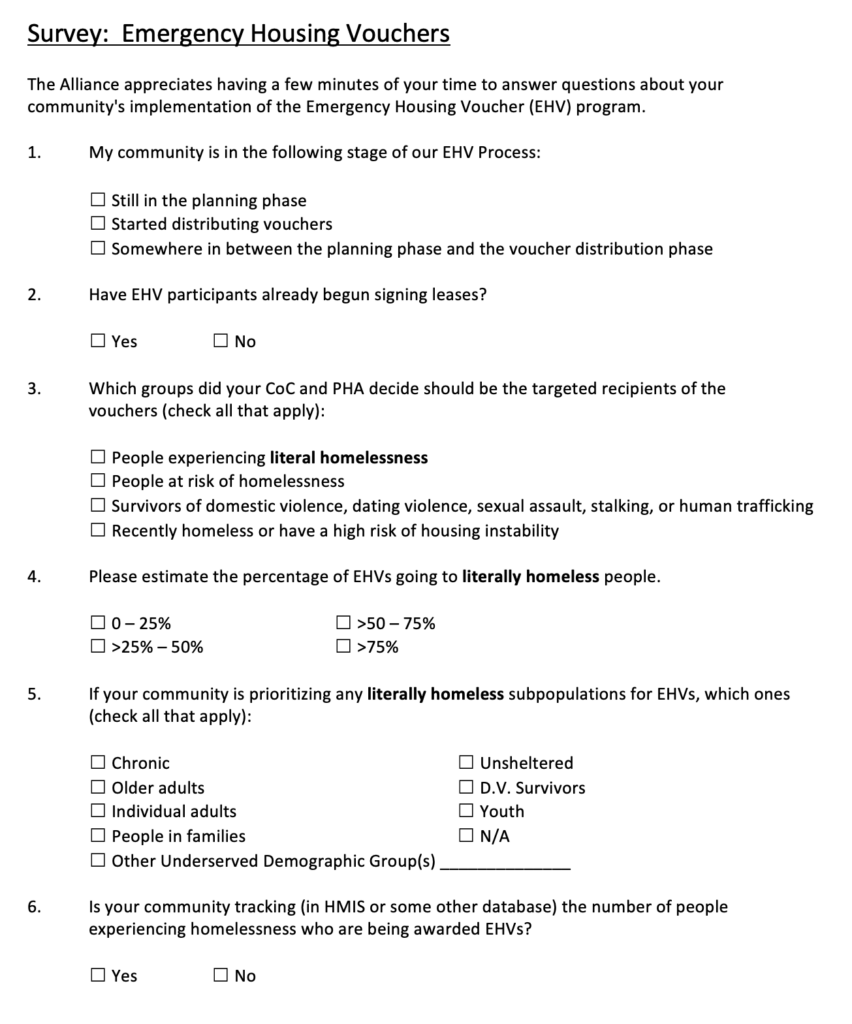
Stay Updated: Solutions, Stories, and Ways to Make an Impact
Sign up to receive updates on the Alliance’s work, including the latest research, advocacy efforts, and real stories of progress — plus ways you can help drive lasting change.












